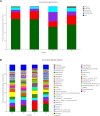High-fiber diet ameliorates gut microbiota, serum metabolism and emotional mood in type 2 diabetes patients
- PMID: 36794003
- PMCID: PMC9922700
- DOI: 10.3389/fcimb.2023.1069954
High-fiber diet ameliorates gut microbiota, serum metabolism and emotional mood in type 2 diabetes patients
Abstract
Previous studies have demonstrated that patients with type 2 diabetes mellitus (T2DM) often had the problems of fecal microbiota dysbiosis, and were usually accompanied with psychiatric comorbidities (such as depression and anxiety). Here, we conducted a randomized clinical study to analyze the changes in gut microbiota, serum metabolism and emotional mood of patients with T2DM after consumption of a high-fiber diet. The glucose homeostasis of participants with T2DM was improved by the high-fiber diet, and the serum metabolome, systemic inflammation and psychiatric comorbidities were also altered. The increased abundances of Lactobacillus, Bifidobacterium and Akkermansias revealed that the proportions of beneficial gut microbes were enriched by the high-fiber diet, while the abundances of Desulfovibrio, Klebsiella and other opportunistic pathogens were decreased. Therefore, the current study demonstrated that the intestinal microbiota alterations which were influenced by the high-fiber diet could improve the serum metabolism and emotional mood of patients with T2DM.
Keywords: anxiety; depression; dietary fiber; gut microbiota; serum metabolome; type 2 diabetes mellitus.
Copyright © 2023 Chen, Liu, Ren, Du, Fei, Qian, Li, Zhang, Liu, Li and Ma.
Conflict of interest statement
Author HL is employed by Sino-science Yikang Beijing Biotech Co., Ltd. The authors declare that the research was conducted in the absence of any commercial or financial relationships that could be construed as a potential conflict of interest.
Figures







Similar articles
-
A specific gut microbiota and metabolomic profiles shifts related to antidiabetic action: The similar and complementary antidiabetic properties of type 3 resistant starch from Canna edulis and metformin.Pharmacol Res. 2020 Sep;159:104985. doi: 10.1016/j.phrs.2020.104985. Epub 2020 Jun 3. Pharmacol Res. 2020. PMID: 32504839
-
Maternal Soluble Fiber Diet during Pregnancy Changes the Intestinal Microbiota, Improves Growth Performance, and Reduces Intestinal Permeability in Piglets.Appl Environ Microbiol. 2018 Aug 17;84(17):e01047-18. doi: 10.1128/AEM.01047-18. Print 2018 Sep 1. Appl Environ Microbiol. 2018. PMID: 29959248 Free PMC article.
-
Pi-Dan-Jian-Qing Decoction Ameliorates Type 2 Diabetes Mellitus Through Regulating the Gut Microbiota and Serum Metabolism.Front Cell Infect Microbiol. 2021 Dec 6;11:748872. doi: 10.3389/fcimb.2021.748872. eCollection 2021. Front Cell Infect Microbiol. 2021. PMID: 34938667 Free PMC article.
-
Pharmacologic and Nonpharmacologic Therapies for the Gut Microbiota in Type 2 Diabetes.Can J Diabetes. 2019 Apr;43(3):224-231. doi: 10.1016/j.jcjd.2019.01.007. Epub 2019 Jan 31. Can J Diabetes. 2019. PMID: 30929665 Review.
-
Effect of traditional Chinese medicine on gut microbiota in adults with type 2 diabetes: A systematic review and meta-analysis.Phytomedicine. 2021 Jul 15;88:153455. doi: 10.1016/j.phymed.2020.153455. Epub 2020 Dec 30. Phytomedicine. 2021. PMID: 33478831
Cited by
-
Effect of Gegen Qinlian Decoction on the regulation of gut microbiota and metabolites in type II diabetic rats.Front Microbiol. 2024 Aug 21;15:1429360. doi: 10.3389/fmicb.2024.1429360. eCollection 2024. Front Microbiol. 2024. PMID: 39234553 Free PMC article.
-
Increasing dietary fiber intake for type 2 diabetes mellitus management: A systematic review.World J Diabetes. 2024 May 15;15(5):1001-1010. doi: 10.4239/wjd.v15.i5.1001. World J Diabetes. 2024. PMID: 38766430 Free PMC article.
-
Characterization of the gut microbiota in urinary calculi patients with preoperative urinary tract infection.Front Cell Infect Microbiol. 2025 Feb 28;15:1417403. doi: 10.3389/fcimb.2025.1417403. eCollection 2025. Front Cell Infect Microbiol. 2025. PMID: 40093533 Free PMC article.
-
The Gut Microbial System Responds to Retinal Injury and Modulates the Outcomes by Regulating Innate Immune Activation.Invest Ophthalmol Vis Sci. 2025 Jul 1;66(9):6. doi: 10.1167/iovs.66.9.6. Invest Ophthalmol Vis Sci. 2025. PMID: 40600763 Free PMC article.
-
Beneficial Effects of Synbiotics on the Gut Microbiome in Individuals with Low Fiber Intake: Secondary Analysis of a Double-Blind, Randomized Controlled Trial.Nutrients. 2024 Jun 29;16(13):2082. doi: 10.3390/nu16132082. Nutrients. 2024. PMID: 38999830 Free PMC article. Clinical Trial.
References
-
- Cani P. D., Possemiers S., Van de Wiele T., Guiot Y., Everard A., Rottier O., et al. . (2009). Changes in gut microbiota control inflammation in obese mice through a mechanism involving GLP-2-driven improvement of gut permeability. Gut 58 (8), 1091–1103. doi: 10.1136/gut.2008.165886 - DOI - PMC - PubMed
-
- Chen T., Liu A. B., Sun S., Ajami N. J., Ross M. C., Wang H., et al. . (2019). Green tea polyphenols modify the gut microbiome in db/db mice as Co-abundance groups correlating with the blood glucose lowering effect. Mol. Nutr. Food Res. 63 (8), e1801064. doi: 10.1002/mnfr.201801064 - DOI - PMC - PubMed
Publication types
MeSH terms
LinkOut - more resources
Full Text Sources
Medical

